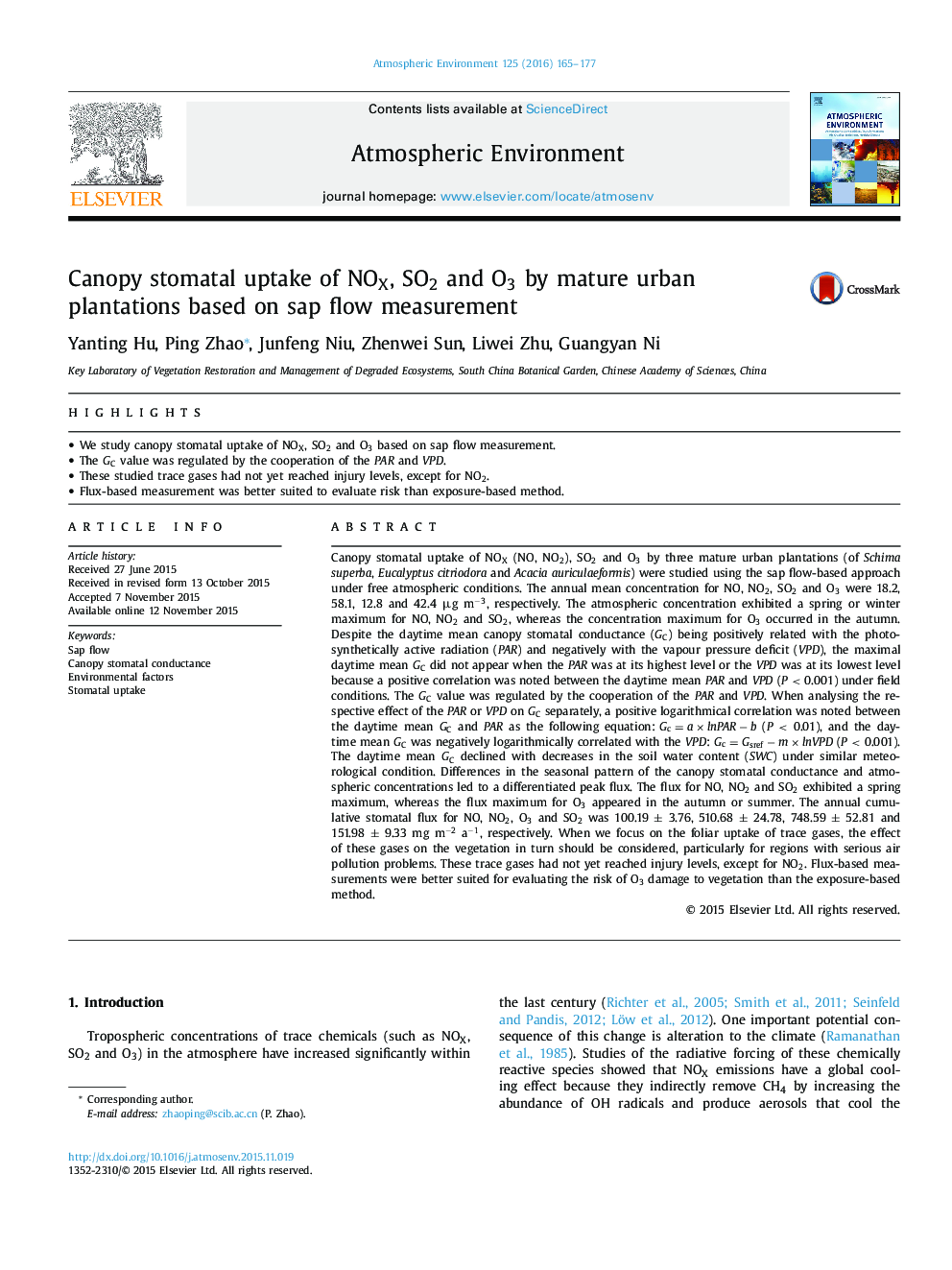| کد مقاله | کد نشریه | سال انتشار | مقاله انگلیسی | نسخه تمام متن |
|---|---|---|---|---|
| 6337248 | 1310933 | 2016 | 13 صفحه PDF | دانلود رایگان |
عنوان انگلیسی مقاله ISI
Canopy stomatal uptake of NOX, SO2 and O3 by mature urban plantations based on sap flow measurement
دانلود مقاله + سفارش ترجمه
دانلود مقاله ISI انگلیسی
رایگان برای ایرانیان
کلمات کلیدی
موضوعات مرتبط
مهندسی و علوم پایه
علوم زمین و سیارات
علم هواشناسی
پیش نمایش صفحه اول مقاله

چکیده انگلیسی
Canopy stomatal uptake of NOX (NO, NO2), SO2 and O3 by three mature urban plantations (of Schima superba, Eucalyptus citriodora and Acacia auriculaeformis) were studied using the sap flow-based approach under free atmospheric conditions. The annual mean concentration for NO, NO2, SO2 and O3 were 18.2, 58.1, 12.8 and 42.4 μg mâ3, respectively. The atmospheric concentration exhibited a spring or winter maximum for NO, NO2 and SO2, whereas the concentration maximum for O3 occurred in the autumn. Despite the daytime mean canopy stomatal conductance (GC) being positively related with the photosynthetically active radiation (PAR) and negatively with the vapour pressure deficit (VPD), the maximal daytime mean GC did not appear when the PAR was at its highest level or the VPD was at its lowest level because a positive correlation was noted between the daytime mean PAR and VPD (P < 0.001) under field conditions. The GC value was regulated by the cooperation of the PAR and VPD. When analysing the respective effect of the PAR or VPD on GC separately, a positive logarithmical correlation was noted between the daytime mean GC and PAR as the following equation:Gc=aÃlnPARâb (P < 0.01), and the daytime mean GC was negatively logarithmically correlated with the VPD: Gc=GsrefâmÃlnVPD (P < 0.001). The daytime mean GC declined with decreases in the soil water content (SWC) under similar meteorological condition. Differences in the seasonal pattern of the canopy stomatal conductance and atmospheric concentrations led to a differentiated peak flux. The flux for NO, NO2 and SO2 exhibited a spring maximum, whereas the flux maximum for O3 appeared in the autumn or summer. The annual cumulative stomatal flux for NO, NO2, O3 and SO2 was 100.19 ± 3.76, 510.68 ± 24.78, 748.59 ± 52.81 and 151.98 ± 9.33 mg mâ2 aâ1, respectively. When we focus on the foliar uptake of trace gases, the effect of these gases on the vegetation in turn should be considered, particularly for regions with serious air pollution problems. These trace gases had not yet reached injury levels, except for NO2. Flux-based measurements were better suited for evaluating the risk of O3 damage to vegetation than the exposure-based method.
ناشر
Database: Elsevier - ScienceDirect (ساینس دایرکت)
Journal: Atmospheric Environment - Volume 125, Part A, January 2016, Pages 165-177
Journal: Atmospheric Environment - Volume 125, Part A, January 2016, Pages 165-177
نویسندگان
Yanting Hu, Ping Zhao, Junfeng Niu, Zhenwei Sun, Liwei Zhu, Guangyan Ni,